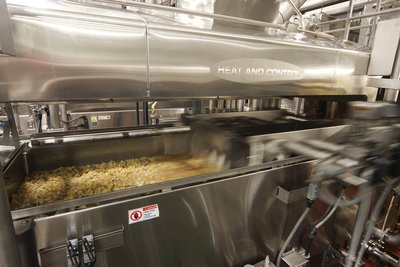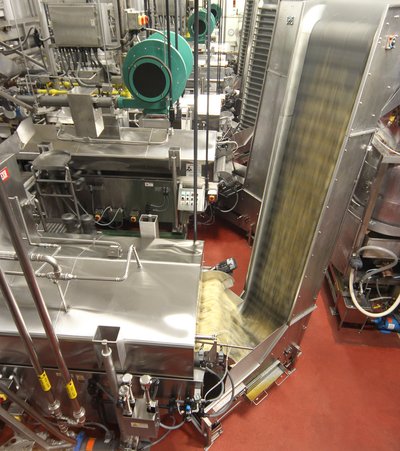Keeping the crunch while raising productivity
Tuesday, 09 April, 2013
Cape Cod Potato Chips produces one of the top-selling brands of batch-cooked potato chips in the US. Hosting more than 250,000 visitors each year, Cape Cod’s plant and store are one of the top tourist destinations on the Cape. An almost cult-like following for the company’s style of distinctively crunchy batch-cooked chips has developed.
When the company decided it needed to significantly boost production capacity to keep up with demand, plant manager Jeff Newell was faced with a conundrum. How do you squeeze higher output from the same floor space used since 1980, without changing product quality or ruining the charm of a popular tourist destination?
“We were space-constrained and simply didn’t have the ability to make the plant bigger with brick and mortar,” Newell said. “The project was based on the premise that the kettles we work with are the original fryers the brand was started with. So our challenge was to replace those fryers without expanding the plant and still make the Cape Cod Potato Chips our customers love.”
Since the original fryers were Heat and Control Mastermatic models, Newell contacted the company to replace six of the 18 batch fryers and then replace the remaining fryers if the project succeeded. Additionally, Newell wanted fryers providing a higher oil turnover rate and a broader, more controllable frying temperature profile.

“The goal was to make the same product whether we have low-gravity potatoes or high-gravities, and do it with much higher throughput,” reasoned Newell.
Heat and Control developed a new fryer based on its proven 800B platform, which closely matched the footprint of the company’s existing fryers. Heat transfer tubes were positioned lateral to product flow with BTUs provided by a new combustion system. To preserve floor space, combustion components were mounted above the fryer, instead of beneath it. PLC-controlled Chip-Stirr systems automatically agitate slices for safe, uniform cooking and discharge of the finished chips.
This design met every one of Newell’s requirements but introduced yet another challenge: how to cost-effectively remove the significantly greater volume of steam and oil vapours generated by the increased chip capacity.
The company had exhaust hoods mounted two metres above each of the old fryers, which pulled a large amount of draft air from the cook room. The new fryers would pull up to 30% more air and add nearly a million dollars to the project for additional air make-up equipment if a similar approach was used.
To eliminate this deal-breaker and save energy, Heat and Control equipped each fryer with a hood enclosure, like those commonly used on continuous fryers. In addition to reducing draft air volume to below 1700 acfm, the hoods blanket the oil with steam, purging oxygen to improve oil quality by reducing oxidation.
Oil Mist Eliminators built into each hood remove oil from exhaust emissions to improve air quality and prevent potentially combustible deposits of oil from coating the roof. Newell says the eliminators and the hoods are a big environmental improvement, both inside and outside of the building.
“This technology exceeded the expectations of the regulatory agency and they were impressed with the lower particulate numbers given our increase in throughput,” he said.
“Heat and Control made sure that the equipment was sized properly, that the combustion system was capable, that the right amount of BTUs were transferred to mimic our profile and that modulation between high and low fire was programmed into the PLC to do anything we wanted to do.”
It also helped that PLC codes for the new equipment were written on the same basic platform as the old systems. This helped start-up run smoothly.
“We started up the first two new fryers on a Monday, the second two on a Tuesday, and the third set on a Wednesday - and it was almost flawless. We started at the target batch size and never turned back. On the first two fryers we were making the right product within five batches. After that, product was as it should be after one or two batches on the remaining fryers,” concluded Newell.

On the old fryers, the temperature profile was sluggish and occurred over a longer period of time. The new fryers are far more responsive, says Newell. “We can now go to whatever bottom temperature we want, so we can get more flexibility to make a little bit harder bite if we want to.
“There is an improvement in product appearance. And because the BTU conversion is so powerful in the new fryers, I get a searing effect early on in the batch cycle which holds the chips to the right number of fold-overs and a good cup shape.
“Texture change is neutral,” he added, “which is a good thing. The fact that I’m making significantly more product in the same size of equipment and not sacrificing any texture is a huge positive.”
“Innovation and collaboration between our two companies yielded a unique solution in terms of square footage and capacity,” said Newell. “What we ended up with was pretty close to the same footprint.
“We got a huge boost in capacity, no changes in brick and mortar, all kinds of finished product profile control, significant quality improvements and a big positive environmental impact.”
Six beverage trends predicted for 2026
Demand for customisation, 'protein-ification' and sustainable storytelling are some of...
Making UHT processing less intensive on energy
A nutritional beverages company was seeking a more sustainable way to produce UHT beverages using...
Tasty twist for chocolate alternatives
Food scientists develop two novel flavour-boosting techniques to transform carob pulp into a...








